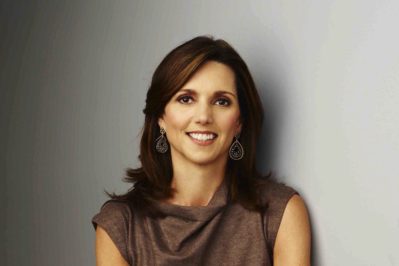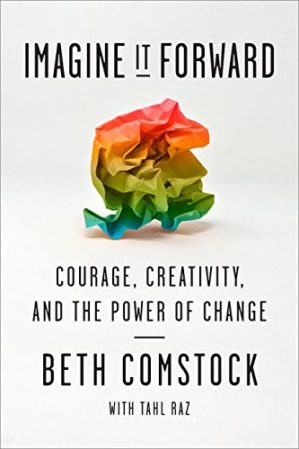While the meteoric rise of new tech startups often captures media attention and public imagination alike, the strength and adaptability of established firms can go overlooked. In this episode of Mastering Innovation on SiriusXM Channel 132, Business Radio Powered by The Wharton School, Beth Comstock, Former Chief Marketing Officer and Vice Chair at GE and author of the new book Imagine It Forward, discusses how to implement new, successful ideas in a large company, let go of career-hindering assumptions, and embrace change.
After joining GE in 2008, Comstock helped lead initiatives like Ecomagination, the company’s push to spur clean technology innovation across a range of industries, from transportation to financial services to healthcare. She elaborates on the particular challenges that established companies face and stresses the importance of building a company culture that encourages learning from failure.
An excerpt of the interview is transcribed below. Listen to more episodes here.
Transcript

Saikat Chaudhuri: I want to start by thinking about the company that you spent so much time with, GE. GE is a company that has successfully adapted and reinvented itself over many decades. We’ll come to the current issues in a bit, but I first want to focus on the success story that is GE. How has GE been so successful throughout its history?
Beth Comstock: Well that’s one thing that gets lost in the swirl of the many great new companies that are coming out. We take for granted the companies that have been around for a while. You don’t get to be a 125-year-old company without going through some ups and downs and bouncing back. Every company has a history and they’re still around to tell it. There’s a resiliency that comes from these companies where they’re able to see change early and adapt to it. That’s what keeps them around so long.
Chaudhuri: With GE, how do you think they were able to adapt and reinvent themselves? We hear a lot about the legend of certain leaders, and that’s certainly part of the story. Is there something about how GE’s strategy has evolved, its organization, that you think has contributed to its ability to successfully adapt itself over time?
“You don’t get to be a 125-year-old company without going through some ups and downs and bouncing back. Every company has a history and they’re still around to tell it.” – Beth Comstock
Comstock: Clearly you need leaders at the top, but that also gets overrated as if one person, just one soul (usually a man), has all the ideas and everybody just marches forward. It clearly doesn’t happen like that. It takes a lot of people who see better ways. They’re living with their customers, they see problems, they stealthily make things happen.
I was fortunate to work, at the end of my time at GE, with the GE lighting business, one of our oldest businesses. Meanwhile, back in the 90s, a stealth group of rebels said, “Hey, in the future we think that light bulb’s going to go away. The future is LED.” On their own, they created their own little skunk works and found a way to keep iterating the technology. Eventually some rebel managers said, “Hey, we’re going to look the other way; we have to make the quarter, but we’re going to look the other way and make sure these guys get funded,” until, by the time I came to work with them, it was a billion-dollar revenue business. That has to still exist within every company that there are these rebel agitators for a better way who just make it happen, and then it becomes so real that managers can’t ignore it.
Chaudhuri: GE has been known to be extremely decentralized and have all these different businesses and different people doing what they want to pursue, but at the same time with some controls. How do you balance this? Having centralization in some respects, decentralization in others, some autonomy, some oversight — how does one achieve that balance?
Comstock: It’s one of the essential questions of business these days, especially with the more distributed, digitized world in which we live. People have to have autonomy, yet there needs to be some core framework. Why do we all exist together? What’s our purpose? What’s the strategy? You can have great ideas, but if it doesn’t match the strategy of what the company is trying to do, why should the company be investing? That’s where people fall off sometimes, if they’re wasting their time and energy on things that may not be moving the company forward. For example, if I decided to go spend all my energy creating a GE ice cream, that might be a great idea for ice cream, but probably not a good idea for GE.

What companies have to do is be very clear on their strategy, which has to evolve. I always like that idea of freedom within a framework. You have the frame, the core tenets, the values, the strategy, and then within your business, your industry, your geography, you have to have the freedom to adapt and make it work there. We did that with the digitization of industry. There were core things that everybody had to sign up for, and yet there were things that if I were in aviation, I could apply it differently to airline customers versus hospital customers.
Companies fall apart with their efforts when they try to centralize too many things. It doesn’t allow for adaptation; it becomes bureaucratic. If it’s too decentralized, you miss resources, you lack a speed to learning. One of the great things about the multi-company model that GE had was that we saw patterns, and things emerged often ahead of our competitors. We saw where things were alike. You don’t have to have multiple industries to do that, but maybe it’s multiple customer segments. Are you doing enough to do the pattern recognition so you can adapt faster?
”Companies fall apart with their efforts when they try to centralize too many things. It doesn’t allow for adaptation.” – Beth Comstock
Chaudhuri: Can you give us an example? What’s your biggest success story that you’ve observed? It may be you, and it may be colleagues that did it at GE. I’m curious to hear more about these examples that you’re referring to.
Comstock: One that I was very passionate about and very close to would have been looking at the evolution of clean technology at a time when clean tech was seen as something that didn’t apply to industry. We were seeing patterns where European customers in multiple industries (railroads, airlines, energy companies) were saying, “Hey, regulation is changing. We need different technologies to compete.” We started to see these patterns, different industries saying, “We need a cleaner technology future.” By seeing that, we noticed that there was a bigger trend there. It wasn’t just the utility companies that were facing this; it was three or four different industries. What could we do to innovate? Was there a core innovation that we could drive?
For us, it became a platform that we called Ecomagination. It had a cute name but a serious intent. We set out to spearhead some innovations, investments in technologies, and new ways of working with customers. It was interesting. We never imagined that the clean tech innovation would necessarily be relevant in financial services or hospitals, but pretty quickly, people in those businesses said, “Wait a minute, my customers have this problem too.” Hospitals need to generate their own energy, they want to be better, and they want to use energy more efficiently. In the case of GE Capital, they said, “Hey, my franchisees at Wendy’s need to better use their energy too. Can we help them?” By seeing those patterns and seeing examples, they could grab them and bring them to new industries.
About Our Guest
Beth Comstock’s mission is to understand what’s next, navigate change and help people and organizations do the same. By cultivating a habit of seeking out new ideas, people and places, she built a career path from storyteller to chief marketer to GE Vice Chair. In nearly three decades at GE, she led efforts to accelerate new growth and innovation, initiated GE’s digital and clean-energy transformation, seeded new businesses and enhanced GE’s brand value and inventive culture.
As President of Integrated Media at NBC Universal, Beth oversaw TV ad revenue and new digital efforts, including the early development of hulu.com. Beth is a director at Nike, trustee of The National Geographic Society and former board president of the Cooper Hewitt Smithsonian National Design Museum. She graduated from the College of William and Mary with a degree in biology. Her first book, Imagine It Forward, about summoning courage and creativity in the face of change, was published September 18, 2018.
Mastering Innovation is live on Thursdays at 4:00 p.m. ET. Listen to more episodes here.



